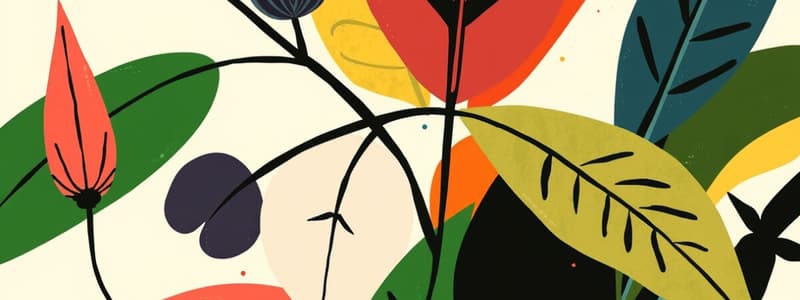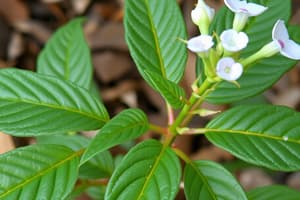Podcast
Questions and Answers
What does the term 'gymnosperm' refer to?
What does the term 'gymnosperm' refer to?
- A type of flowering plant that produces seeds enclosed in fruit
- A plant that reproduces using spores instead of seeds
- A plant that does not have any physical seeds or flowers
- A type of plant that produces seeds without any enclosing fruit (correct)
What does it mean when a plant is described as 'prostrate'?
What does it mean when a plant is described as 'prostrate'?
- The plant has a bushy and dense growth form
- The plant grows lying flat on the ground (correct)
- The plant grows vertically and reaches great heights
- The plant has a climbing habit and grows upwards
What is the significance of trichomes on plants?
What is the significance of trichomes on plants?
- They provide protection and can aid in moisture retention (correct)
- They are the primary structure for nutrient absorption
- They aid in the reproduction of the plant
- They are responsible for photosynthesis in the leaves
What does it mean when a plant is classified as 'invasive'?
What does it mean when a plant is classified as 'invasive'?
Which of the following best describes the term 'dioecious'?
Which of the following best describes the term 'dioecious'?
Flashcards are hidden until you start studying
Study Notes
Plant Terminology Overview
- Terminology relates to plant anatomy and classification.
- Important to understand leaf morphology, plant habits, and life cycles.
Clintonia uniflora
- Leaf margin is smooth and entire.
- Leaf venation is parallel, characteristic of monocots.
- Classified as a eudicot (not a monocot).
Rubus parviflorus
- This plant typically has a biennial life span.
- Habit is erect and may become woody over time.
- Leaf shape is palmately lobed, resembling a hand with fingers.
Sambucus cerulea
- Commonly known as blue elderberry.
- Leaf complexity is compound, featuring multiple leaflets.
- Habit is often shrub-like, reaching several meters in height.
Galium triflorum
- Leaf arrangement is whorled, with leaves around the stem.
- Prostrate growth means it grows horizontally along the ground.
- Trichomes are hair-like structures that can serve various functions, including protection.
Pinus ponderosa
- This tree falls under the category of gymnosperms, which produce seeds without flowers.
- Needles are found in bundles of three.
- Needles are long and flexible, with a distinctive yellowish-green color.
Corylus cornuta
- Leaf margin is serrated, characterized by sharp notches.
- Leaf venation is palmate, with veins radiating from a central point.
- Leaf arrangement is alternate, with leaves positioned staggered along the stem.
Centaurea stoebe
- This plant is often classified as a biennial, completing its life cycle over two years.
- Plant habit is erect and branching, frequently reaching heights of 1 meter.
- Described as invasive, meaning it spreads aggressively and outcompetes native species.
Symphoricarpos albus
- Leaf arrangement is opposite, with pairs of leaves at each node.
- Leaf complexity is simple, featuring single leaf structures.
- Leaf shape is broadly oval to elliptic, with entire margins.
Prunus virginiana
- Leaf arrangement is alternate, with leaves spaced along the stem.
- Leaf complexity is simple, consisting of a single leaf blade.
- Lenticels are small, raised pores on stems helping with gas exchange.
Populus tremuloides
- This species is an angiosperm, characterized by flowering and seed production.
- The petiole is flattened, allowing leaves to flutter in the wind for maximum sunlight.
- Dioicous means this plant has separate male and female individuals for reproduction.
Studying That Suits You
Use AI to generate personalized quizzes and flashcards to suit your learning preferences.




